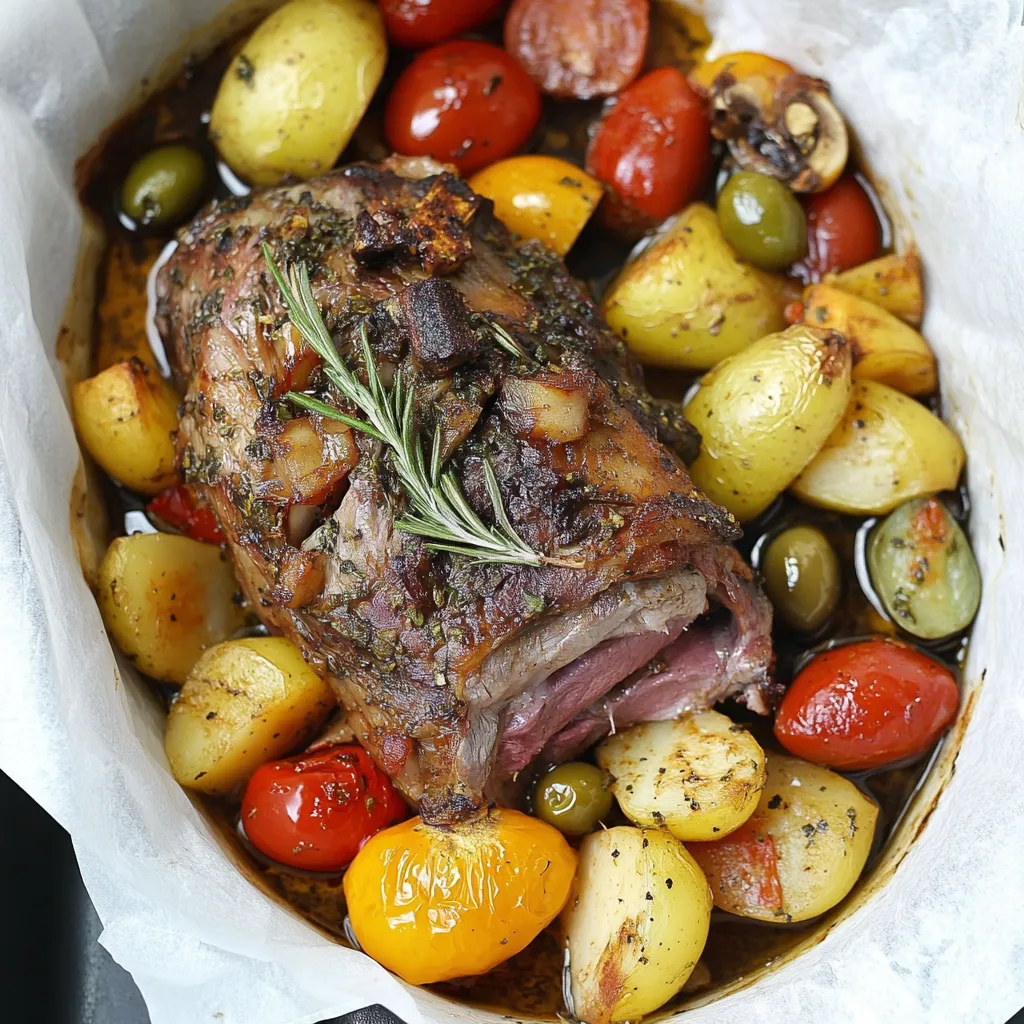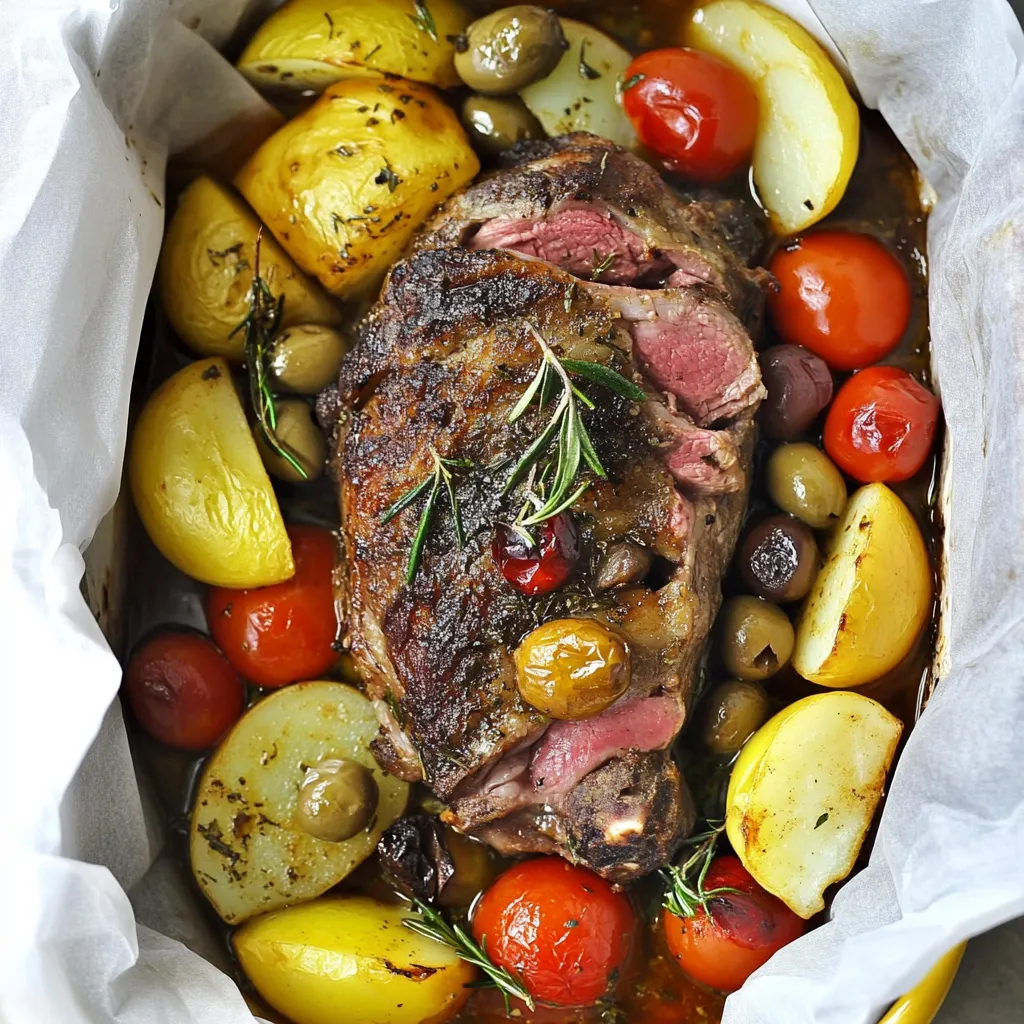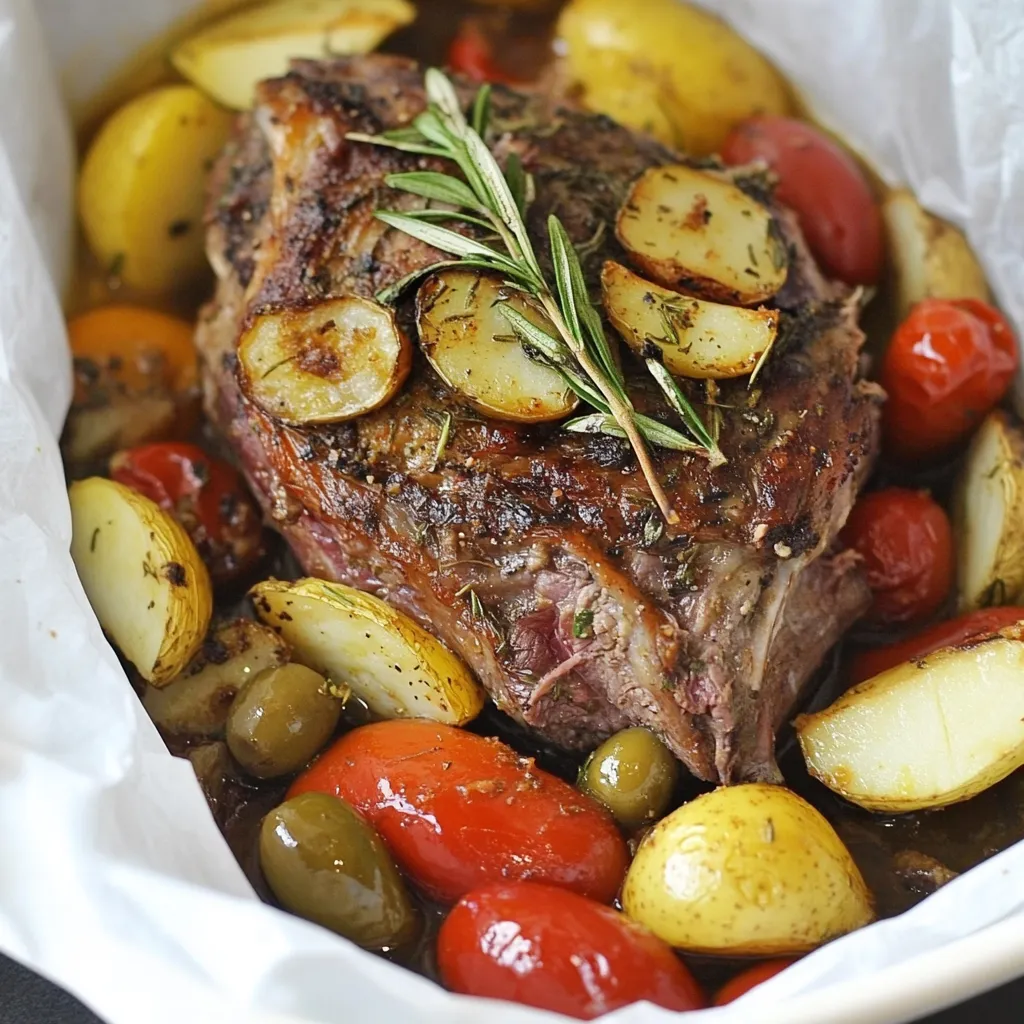 Pin it
Pin it
This traditional Greek lamb kleftiko brings Mediterranean flavors right to your dining table with tender, fall-apart meat and perfectly roasted vegetables. The slow-roasting method in parchment paper creates an incredibly moist environment that infuses the lamb with herbs and spices while the vegetables absorb all those wonderful juices.
I first made this kleftiko for a family gathering after returning from a trip to Greece. The moment everyone tasted it, conversations stopped and were replaced by appreciative murmurs. Now it's become our special occasion tradition, especially during Easter celebrations.
Ingredients
- Boneless leg of lamb: Requires minimal prep and becomes incredibly tender when slow-roasted
- Extra virgin olive oil: Provides the authentic Mediterranean base for the marinade
- Fresh lemon juice: Adds brightness and helps tenderize the meat
- Garlic slices: Infuse throughout the dish during the long cooking process
- Fresh rosemary and dried herbs: Create the signature Greek flavor profile
- Cinnamon: Introduces a subtle warmth that complements the lamb beautifully
- Honey: Balances the acidity and helps with caramelization
- Dijon mustard: Adds depth and helps emulsify the marinade
- Chunky vegetables: Potatoes, tomatoes, and bell peppers absorb the flavorful juices
- White wine: Creates steam within the parchment packet and deglazes all the flavorful bits
Step-by-Step Instructions
- Prepare the lamb:
- Score the meat by making shallow diagonal cuts across the top surface about 1/4 inch deep and 1 inch apart. This allows the marinade to penetrate deeply and creates more surface area for browning. Pat the meat completely dry first for the best marinade adhesion.
- Create the marinade:
- Combine olive oil, lemon juice, garlic, herbs, spices, honey, mustard, salt and pepper in a bowl and whisk until fully incorporated. The marinade should be thick enough to cling to the meat. Reserve 2 tablespoons for the vegetables before applying the rest to the lamb.
- Marinate thoroughly:
- Massage the marinade into every surface of the lamb, pushing it into the score marks and ensuring complete coverage. This step is crucial for flavor development, so take your time. Wrap tightly in plastic and refrigerate for at least 5-6 hours, though overnight marination will yield the most tender results.
- Prepare the parchment package:
- Create a cross pattern with two large parchment sheets in your roasting pan, leaving substantial overhang on all sides. This creates a sealed environment that traps moisture and intensifies flavor. The parchment should be large enough to completely wrap and seal around the entire dish.
- Layer the ingredients:
- Arrange the vegetable chunks on the bottom of the parchment, season with the reserved marinade, then place the marinated lamb on top. Pour wine along the edges to create steam during cooking without washing off the marinade. The layering allows vegetables to absorb dripping juices.
- Seal and slow roast:
- Fold the parchment to create a completely sealed package, crimping and folding edges to prevent steam from escaping. The slow cooking at 375°F for 4 hours allows collagen to break down completely, resulting in that signature melt-in-your-mouth texture.
- Finish with browning:
- After the long, slow cook, open the parchment and increase the temperature to 425°F for 15-20 minutes. This final step creates a beautiful caramelized exterior while the inside remains juicy. Watch carefully during this stage to prevent burning.
 Pin it
Pin it
My grandmother always insisted on using cinnamon in her lamb dishes, a tip I initially questioned but now consider essential. She taught me that the key to perfect kleftiko isn't rushing the process but allowing time for the flavors to meld and the meat to become sublimely tender.
The History Behind Kleftiko
Kleftiko translates to "stolen meat" and dates back to when Greek resistance fighters (klephts) would steal sheep and cook them in sealed underground pits to avoid detection. The smoke-free cooking method prevented their enemies from finding them. Modern kleftiko recreates this sealed-cooking approach using parchment paper instead of underground pits. This historical cooking method unintentionally created one of the most tender, flavorful lamb dishes in Mediterranean cuisine.
Serving Suggestions
Serve this spectacular dish family-style on a large platter surrounded by the roasted vegetables. Traditional Greek accompaniments include tzatziki sauce for cooling contrast, a simple Greek salad with feta, and warm pita bread to soak up the incredible juices. A side of lemon rice or orzo pasta with fresh herbs complements the rich flavors beautifully. This feast deserves to be enjoyed with a glass of robust Greek red wine like Agiorgitiko or Xinomavro.
Make-Ahead and Storage Tips
Kleftiko is perfect for entertaining because most of the work happens in advance. The lamb can be marinated up to 24 hours before cooking, developing deeper flavors the longer it sits. Once cooked, leftovers store beautifully in the refrigerator for up to 3 days, with flavors actually improving overnight. For freezing, separate the meat from vegetables and store in airtight containers for up to 3 months. Thaw overnight in the refrigerator and reheat gently in a 300°F oven with a splash of broth to maintain moisture.
 Pin it
Pin it
Enjoy the tender, juicy lamb kleftiko as it elevates your dining experience with rich flavors and centuries of tradition.
Frequently Asked Questions
- → Can I use a different cut of lamb for Kleftiko?
Yes, you can use lamb shoulder as an alternative to leg of lamb. The important factor is choosing a cut that benefits from slow cooking. Bone-in cuts will add flavor but require longer cooking time. Whatever cut you choose, ensure it has enough fat marbling for maximum tenderness.
- → What if I don't have parchment paper for cooking Kleftiko?
Aluminum foil makes an excellent substitute for parchment paper when preparing Kleftiko. Ensure you create a tight seal to trap moisture. Alternatively, you can use an oven bag designed for roasting, or a Dutch oven with a tight-fitting lid to achieve similar results.
- → Can I prepare Kleftiko in advance for a dinner party?
Absolutely! Kleftiko actually improves with time as flavors develop. You can marinate the lamb up to 24 hours ahead, and even cook the entire dish a day before serving. Simply reheat gently in a covered dish at 325°F until hot throughout, adding a splash of broth if needed to maintain moisture.
- → What sides go well with Lamb Kleftiko?
Traditional Greek sides that complement Kleftiko beautifully include a Greek salad with feta, tzatziki sauce, warm pita bread, and perhaps some lemon rice or orzo pasta. The dish already contains vegetables, but additional roasted vegetables like eggplant or zucchini also pair wonderfully.
- → How can I tell when the Kleftiko is perfectly cooked?
Perfectly cooked Kleftiko should be fork-tender - the meat should easily pull apart with minimal resistance. The internal temperature should reach about 195°F for that melt-in-your-mouth texture. If you're unsure, give the lamb a little longer at a low temperature rather than rushing it, as this dish benefits from patience.
- → Can Kleftiko be frozen?
Yes, Kleftiko freezes exceptionally well. Allow it to cool completely, then separate the meat and vegetables into appropriate containers. Freeze for up to 3 months. Thaw overnight in the refrigerator and reheat slowly in a covered dish with some of the original juices or a splash of broth.
